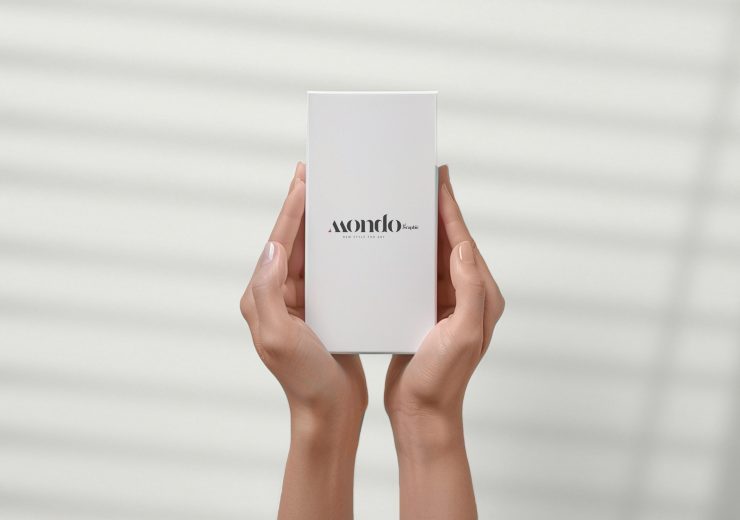How to Brand Your Business by Channel

1. Website
Your website is a major part of your company identity — if it doesn’t reflect your brand, it will only create a jarring customer experience. Also, be sure that all web copy, calls-to-action, and product descriptions speak with your brand voice.
Real-Life Brand Example: Shopify
Shopify‘s website perfectly embodies its brand. The clean, minimal design and straightforward copy reflect Shopify’s mission to simplify ecommerce. Consistent use of brand colors, fonts, and illustrations create a cohesive experience.
Testing It Out
For the social media marketing platform’s website, I applied the teal and gray color scheme and rounded, friendly fonts. The copy emphasizes ease-of-use and authentic connection, in line with the brand voice. Customer testimonials and case studies showcase successful small businesses to inspire and build trust.
2. Social Media
Increasing brand awareness is a top goal for social marketers, according to 2022 research. All profile photos, cover art, and branded imagery should reflect your brand. Consider putting your logo as your profile photo. This will make it easier for customers to recognize your business. As with your website, be sure all profile information, posts, and captions show off your brand voice.
Real-Life Brand Example: Wendy’s
Wendy’s social media presence is a masterclass in branding. Their profile photos feature their iconic logo and mascot. Their tweets are sassy, playful and on-brand.
Testing It Out
Across social profiles, I used the branded chat bubble logo icon as the profile photo. Cover images feature the vibrant teal and photos of small business owners connecting with customers. Captions are written in a friendly, encouraging brand voice, with tips and resources to help small businesses grow using social media.
Consistent use of branded hashtags (#AuthenticSocialGrowth) reinforces key messaging.
3. Packaging
If you have a physical products business, your product is probably the most tangible way that customers interact with your brand. For that reason, your packaging should highlight your new branding — in its design, colors, size, and feel.
Real-Life Brand Example: Chobani
I love Chobani yogurt (confession: I’m eating it right now). Their branding immediately tells me that they produce authentic, healthy Greek yogurt.
That’s one of the main reasons I buy Chobani. It makes its yogurt packaging with recyclable paper cups — an intentional decision that supports the overall experience they’ve paired with purchasing and eating the Chobani brand.
4. Advertising
Advertisements (digital and print) are often used to establish brand awareness and introduce consumers to your brand. In fact, according to HubSpot research, 33% of marketers use paid ads to increase brand awareness.
Because of this, it’s critical that they display your branding. In fact, your branding should make the ad creation process easier. With your brand style guide, you already know how your ads should appear and what type of copy to write.
Real-Life Brand Example: Oatly
Oatly‘s ads are quirky, bold, and instantly recognizable. With irreverent copy, stark black and white imagery, and the consistent Oatly logo, they command attention. The ads perfectly capture Oatly’s unconventional brand.
Testing It Out
Digital ads for the social media marketing platform feature bold text in the brand fonts and colors.
Copy focuses on the pain points of the target audience (“Struggling to grow your small biz on social? We can help!”) and the benefits of the platform.
Branded illustrations catch the eye while reinforcing the message. A clear CTA encourages clicks.
5. Sales and Customer Service
A brand is only as powerful as the people behind it, and if your people aren’t putting your brand to work, it won’t work for you. Moreover, your brand applies to more than your marketing.
Inform your sales and customer service folks of your brand guidelines and tell them to use them, especially when they engage directly with customers. Whether they’re sharing a branded product demo or answering customer questions, encourage them to use your logo, tagline, imagery, and brand voice.
Real-Life Brand Example: Amazon
Amazon is known for its exceptional customer service, which is a key part of its brand promise. For example:
- 24/7 customer support via phone, email, and chat
- No-hassle returns and exchanges
- Proactive communication about delays or issues with orders
- Personalized recommendations based on purchase history
Testing It Out
I developed a brand training for all customer-facing teams. It covers the platform’s mission, target audience, brand voice, and visual guidelines. I also provided buyer personas using persona templates so teams understand who they’re addressing better.
Sales reps use branded slides for demos, and stress ease-of-use and authentic connection in their pitches. Customer service reps spend as much time as needed to help small business owners succeed on the platform, in a friendly and encouraging tone. All teams have easy access to approved brand assets.
Check out these examples of small business branding for more inspiration.
Branding Terms to Know
Here are some other brand-related buzzwords you should know. They show the importance and value of branding your business.
Brand Awareness
Brand awareness refers to how familiar the general public and your target audience are with your brand. High brand awareness leads to brands being referred to as “trending,” “buzzworthy,” or “popular.”
Brand awareness is important because consumers can’t consider purchasing from your brand if they’re not aware of it.
Brand Extension
Brand extensions are when companies “extend” their brand to develop new products in new industries and markets. Consider Honda lawn mowers or Martha Stewart “Good Things.”
Brand extensions allow companies (or individuals) to leverage brand awareness and equity to create more revenue streams and diversify product lines.
Brand Identity
Brand identity is the personality of your business and the promise you make to your customers. It’s what you want your customers to walk away with after they interact with your brand.
Your brand identity is typically composed of your values, how you communicate your product or service, and what you want people to feel when they interact with it.
Brand Management
Brand management refers to the process of creating and maintaining your brand.
It includes managing the tangible elements of your brand (style guide, packaging, color palette) and the intangible elements (how it’s perceived by your target audience and customer base).
Your brand is a living, breathing asset, and it should be managed as such.
Brand Recognition
Brand recognition is how well a consumer (ideally in your target audience) can recognize and identify your brand without seeing your business name — through your logo, tagline, jingle, packaging, or advertising.
This concept goes hand-in-hand with brand recall, which is the ability to think of a brand without any visual or auditory identifiers.
Brand Trust
Brand trust refers to how strongly customers and consumers believe in your brand.
Do you deliver on your marketing promises? Do your salespeople and customer service go above and beyond?
These things can create trust among your customers, which is important in a world where a mere 14% of people feel confident in large businesses.
5. Create your visual assets.
At this point, you should understand your target audience, your mission statement, and the unique qualities that make up your business.
Can you say with confidence that you’ve finished these steps? If your answer is yes, it’s time to move on to one of the more exciting parts of branding — the visual design. We’re talking about your logo, color palette, typography (fonts), iconography, and other visual components.
As you create these elements, build a set of brand guidelines (or a brand style guide) to govern the composition and use of your visual assets.
This will ensure that whoever uses your new branding does so accurately and consistently. Check out these examples of brand style guides for some inspiration.
Note: Design can be just as intimidating as it is exciting. Consider hiring a professional with logo and identity design experience or starting with a few helpful design templates.
Testing It Out
For the social media marketing platform, I selected:
- Logo. A chat bubble icon incorporating an upward trending arrow to symbolize growth through conversation
- Colors. A vibrant, friendly teal as the primary color. Gray and white as secondary colors.
- Fonts. A rounded, approachable sans-serif font for headings. A clean, easy-to-read sans-serif for body copy.
- Imagery. Photos featuring small business owners connecting with customers and growing their business. Minimalist illustrations. These visual elements create a cohesive brand feel that’s modern, approachable, and conveys growth.





